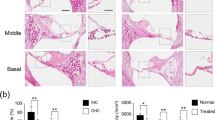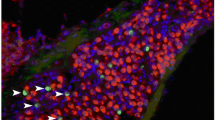Summary
Sound stimuli of 4 different frequencies (50 Hz 110 db, 1,000 Hz 110 db, 5,000 Hz 100 db and 10,000 Hz 100 db) were applied to guinea-pigs for periods between 35 min and 16 hours. Histological sections of the nucleus cochlearis of both sides were made. Each nucleus cochlearis was divided into a cranial, medial and caudal area. In each of these 6 areas the diameters of 250 nuclei of nerve cells were measured and the content of Nisslsubstance was determined in 400 nerve cells.
The following results were obtained:
-
A
Nuclear Size
-
1.
Each tone stimulus causes a definite, statistically significant change of nuclear size. With stimulation of 10,000 Hz the maximum volume was already reached after 4 hours, with 1,000 Hz after 8 hours and with 50 Hz only after 16 hours. The nuclear volume becomes nearly twice as large as that found in the controls.
-
2.
After stimulation with 10,000 Hz for more than 4 hours a diminution of the nuclear volume as well as sporadic pyknosis and karyorrhexis was found.
-
3.
The smallest increase of nuclear volume was seen in the test with 5,000 Hz. The maximum volume was already reached after 35 min.
-
4.
Within the nucleus cochlearis no tone-specific areas were found. In the cranial part of the nucleus, the smallest increase and in the caudal part the most pronounced increase of nuclear volume was found.
-
5.
There were no regular differences of nuclear size between the right and left nucleus cochlearis.
-
1.
-
B.
Content of Nissl-Substance
-
6.
In all stimulation experiments corresponding areas of the right and left nucleus cochlearis were found to contain roughly the same amount of Nisslsubstance.
-
7.
Following stimulation with 50 Hz and 1,000 Hz, the percentage of “light” cells decreases after 35 min stimulation and in all experiments increases up to the 16-hour-test. In the 5,000 Hz experiment the maximum content of “light” cells was already reached after 8 hours and in the 10,000 Hz experiment after 4 hours. These results indicate that the efficiency of synthesis proteins and RNS depends on the strength of the stimulus.
-
8.
Independently of time and frequency of the tone stimulation a diminution — expressed as percentage — of the so called “light” cells, which may undergo chromatolysis, appeared in apico-basal direction. There was a corresponding increase of the “medium” cells. Yet the nerve cells rich in Nissl-substance (“dark” cells) did not show any regularity with respect to their distribution.
-
9.
In the series with stimulation with 50, 1,000 and 5,000 Hz the “light”, “medium” and “dark” cells are present in about the same percentage. This is in contrast to stimulation with 10,000 Hz. Apparently in guinea-pigs the frequency of 10,000 Hz lies beyond the range of hearing.
-
10.
With all frequencies the maximal decrease in “dark” cells is reached after 35 min stimulation. A longer time of tone stimulation causes only small further differences.
-
11.
In the nuclei cochleares of both sides no localisation specific for particular frequencies were found.
-
6.
Conclusion from A and B: Independently of the tone qualities there are definite relations between nuclear volume and the content of Nissl-substance: In a given cell, the more pronounced the functional nuclear swelling, the smaller is the content of Nissl-substance.
Zusammenfassung
Meerschweinchen wurden Schallreizen von 4 Frequenzen (50 Hz 110 db, 1000 Hz 110 db, 5000 Hz 100 db und 10000 Hz 100 db) zwischen 35 min und 16 Std ausgesetzt. Vom Nucleus cochlearis beider Seiten wurden Querschnittsserien angefertigt und jedes Kerngebiet in einen cranialen, medialen und caudalen Bereich unterteilt. Aus jedem dieser 6 Bereiche bestimmten wir von 250 Ganglienzellkernen ihre Durchmesser und prüften 400 Ganglienzellen auf ihren Nissl-Gehalt.
Wir konnten folgende Befunde erheben:
-
A.
Kerngröße
-
1.
Jeder Reizton ruft eine bestimmte, statistisch gesicherte Kernvolumenveränderung hervor. So ist bei einer Beschallung mit 10000 Hz das Volumenmaximum bereits nach 4 Std, bei 1000 Hz nach 8 Std und bei 50 Hz erst nach 16 Std erreicht. Das Kernvolumen hat sich dabei gegenüber den Kontrollversuchen gleichmäßig um 45% erhöht.
-
2.
In der 10000 Hz-Serie finden sich bei länger als 4 Std dauernder Reizeinwirkung Kernvolumenverkleinerungen mit vereinzelten Kernpyknosen und Karyorrhexis.
-
3.
Geringste Kernschwellungen zeigt der 5000 Hz-Versuch, in dem allerdings das Volumenmaximum schon nach 35 min erreicht wird.
-
4.
Innerhalb des Nucleus cochlearis ließen sich keine tonspezifischen Ansprechgebiete feststellen. Seine cranialen Kerne zeigten die geringste, seine caudalen die größte Schwellung.
-
5.
Gesetzmäßige Kerngrößendifferenzen zwischen rechtem und linkem Acusticuskomplex konnten nicht ermittelt werden.
-
1.
-
B.
Nissl-Substanz
-
6.
Rechter und linker Acusticuskomplex enthalten bei allen Beschallungs-versuchen in korrespondierenden Gebieten etwa gleich viel Nissl-Substanz.
-
7.
Nach Beschallung mit 50 und 1000 Hz nehmen die Prozentwerte für die “hellen” Zellen nach anfänglichem Abfall beim 35 min-Versuch ständig bis zum 16 Std-Versuch zu. Beim 5000 Hz-Versuch ist der maximale Gehalt an “hellen” Zellen schon nach 8 Std, bei der 10000 Hz-Serie schon nach 4 Std erreicht. Die Resyntheseleistung an Eiweiß bzw. RNS ist demnach von der Reizgröße abhängig.
-
8.
Unabhängig von der Beschallungszeit und-frequenz zeigte sich in apicobasaler Richtung eine prozentuale Abnahme der von Chromatolyse betroffenen, sog. “hellen” Zellen und eine entsprechende Zunahme der “mittleren” Zellen. Bei den Ganglienzellen mit reichlicher Nissl-Substanz (“dunkle” Zellen) lassen sich hingegen keine Gesetzmäßigkeiten in bezug auf ihre Verteilung erkennen.
-
9.
In der 50, 1000 und 5000 Hz-Serie zeigen die “hellen”, “mittleren” und “dunklen” Zellen im Gegensatz zur 10000 Hz-Serie einen fast gleichmäßigen prozentualen Anteil. Offenbar liegt diese Frequenz von 10000 Hz jenseits des optimalen Hörbereichs des Meerschweinchens.
-
10.
Die “dunklen” Zellen erfahren ihren größten Schwund bei allen Frequenzen schon nach 35 min Beschallung. Längere Zeiten bewirken nur noch geringfügige Veränderungen.
-
11.
In den beidseitigen Acusticuskomplexen konnten wir keine frequenzspezifische Lokalisation ermitteln.
-
6.
Folgerung aus A und B: In den Ganglienzellen bestehen unabhängig von den Tonqualitäten zwischen Kerngröße und Nissl-Gehalt bestimmte Beziehungen: je größer die “funktionelle Kernschwellung”, um so geringer ihr Gehalt an Nissl-Substanz.
Similar content being viewed by others
Literatur
Altmann, H. W.: Allgemeine morphologische Pathologie des Cytoplasmas. In: Handbuch der allgemeinen Pathologie, Bd. 2, S. 419–521. Berlin-Göttingen-Heidelberg: Springer 1955.
Hamberger, C. A., Hyden, H.: Cytochemical changes in the cochlear ganglion caused by acoustic stimulation and trauma. Acta oto-laryng. (Stockh.) Suppl. 61 (1945).
——: Production of nucleoproteins in the vestibular ganglion. Acta oto-laryng. (Stockh.) Suppl. 75, 53–81 (1949).
Kulenkampff, H.: Das Verhalten der Vorderwurzelzellen der weißen Maus unter dem Reiz physiologischer Tätigkeit. Z. Anat. Entwickl.-Gesch. 116, 143–156 (1951).
Rose, J. E.: Microelectrode studies of the cochlear nuclei of the cat. Bull. Johns Hopk. Hosp. 104, 211–217 (1959).
—, Galambos, R., Hughes, J. R.: Tonotopic organisation of frequency sensitive units of the cochlear nuclei of the cat. Anat. Rec. 127, 358 (1957).
Wüstenfeld, E.: Experimentelle Untersuchungen zum Problem der Schallanalyse im Innenohr. Z. mikr.-anat. Forsch. 63, 327–387 (1957).
—, Gleiss, H.: Über die Beeinflussung der Kerngröße von Ganglienzellen durch Reinton-beschallung im medullären Akustikuskomplex des Meerschweinchens. Anat. Anz., Erg. H. 125, 447–459 (1969).
—, Schilling, R.: Veränderungen der NISSL-Substanz im Ganglion spirale cochleae unter Reintonbeschallung. Z. Zellforsch. 71, 517–524 (1966).
Author information
Authors and Affiliations
Additional information
Mit dankenswerter Unterstützung durch die Deutsche Forschungsgemeinschft.
Rights and permissions
About this article
Cite this article
Wüstenfeld, E., Kallenbach, G. & Kallenbach, H. Über die Beeinflussung von Kerngröße und Nissl-Substanz in den Ganglienzellen des medullären Acusticuskomplexes nach Reintonbeschallung (Meerschweinchen). Z. Anat. Entwickl. Gesch. 131, 353–363 (1970). https://doi.org/10.1007/BF00519976
Received:
Issue Date:
DOI: https://doi.org/10.1007/BF00519976




